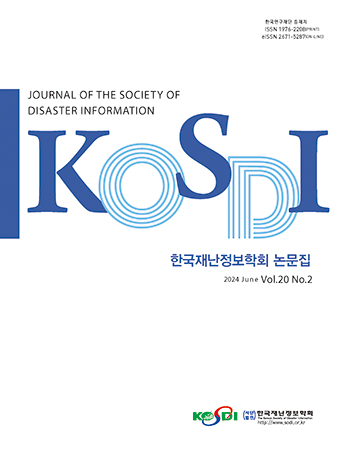Research Article
Abstract
References
Information
Purpose: The purpose of this study is to propose an educational program for enhance safety capability of elementary and middle school students through community mapping application. Method: Developed and utilized a community mapping application that can be easily used for research. After participating in 425 elementary and middle school students, This study analyzed the change of safety competency through survey. Results: Through the community mapping activities, it was possible to derive the actual life surrounding risk factors of the earthy life, and it was found through the questionnaire before and after the activity that the safety competence of the participants improved. Conclusion: Investigation of similar related cases of Public Participant Safety Mapping Tool and analysis of their functionalities are conducted, and user demanded functionalities with improved usability·accessability·expandability are derived. Also, the system applied the test to elementary and middle school students and the survey showed that the safety capacity was improved according to Safety Mapping activities. This is proposed as a safety education program.
연구목적: 본 연구는 커뮤니티맵핑 어플리케이션을 통한 초‧중생 안전역량 제고를 위한 교육 프로그램 제안을 목적으로 한다. 연구방법: 연구를 위해 쉽게 사용할 수 있는 커뮤니티맵핑 어플리케이션을 개발, 활용하여 초‧중생 약 425명이 참여한 후 설문조사를 통해 안전역량 변화를 분석하였다. 연구결과: 커뮤니티맵핑 활동을 통해 초‧중생의 실제 생활주변 위험요소를 도출할 수 있었고 활동 전‧후 설문조사를 통해 참가자의 안전역량이 향상되었음을 알 수 있었다. 결론: 본 연구에서는 참여형 맵핑 툴과 유사한 기능을 포함하며 사용자의 편의성, 접근성, 확장성이 있는 커뮤니티맵핑 어플리케이션의 개발을 통해 어린이 안전교육의 하나의 콘텐츠로 활용하여 등록된 정보를 활용하고 초‧중생의 안전역량 제고를 기대한다.
- Han, S.W. (2013). “A Powerful Tool for Solving Urban Problems, Community Mapping.” BDI Focus, Vol. 200, pp.1-12.
- Innes, J.E., Booher, D.E. (2004). “Reframing Public Participation: Strategies for the 21st Century.” Planning Theory & Practice, Vol. 5, No. 4, pp. 419-436.10.1080/1464935042000293170
- Innes, J.E., Booher, D.E. (2004). “Reframing Public Participation: Strategies for the 21st Century.” Planning Theory & Practice, Vol. 5, No. 4, pp. 419-436.10.1080/1464935042000293170
- Kim, S.G. (2013). “A Map that Utilizes Collective Intelligence of Citizen.” Ulsan Development, Vol. 41, pp. 66-75.
- Korea Safety Map, www.safemap.go.kr.
- Lee, J.H., Yang, G.G., Kim, K.J. (2018). “Research on Actual Status and Development of Children’s Disaster & Safety Education: Based on Survey of Elementary School Students.” Journal of Government Studies, Vol. 13, No. 2, pp. 63-95.10.16973/jgs.2018.13.2.003
- Lee, M.K. (2005). “Public Participation and Urban Development.” Architecture & Urban Research Information Center, Vol.85, pp. 95-113.
- Namuwiki. (2018). Heinrich&’s law, http://namu.wiki.
- National Disaster Safety Research Institute. (2015). Research on the Detection and Evaluation Method for Public Safety Elements and a Process for Integration of Public Safety Improvement Project, pp. 13-16.
- National Disaster Safety Research Institute. (2016). Development of Public Participatory Safety Mapping Tool, pp.23-23.
- National Disaster Safety Research Institute. (2016). Development of Technology in Participatory Safety Mapping, pp. 3-11.
- Safety e-Report, www.safetyreport.go.kr.
- Self-Healing Naver blog. (2018). The Swiss Cheese Model, https://blog.naver.com.
- Sieber, R. (2006). “Public Participation Geographic Information Systems: A Literature Review and Framework.” Annals of the Association of American Geographers, Vol. 96, No. 3, pp. 491-507.10.1111/j.1467-8306.2006.00702.x
- Yamashita. J. (2009). “A study on a short history of PPGIS research and its current issues: a perspective from human geography.” bulletin of the Graduate School of Social and Cultural Studies, Vol. 13, pp. 33-43.
- YanoKeishi. (2009). “Present of Japanese Culture Digital Humanities.” Nakani Shear Publication, pp. 51-64.
- Publisher :The Korean Society of Disaster Information
- Publisher(Ko) :한국재난정보학회
- Journal Title :Journal of the Society of Disaster Information
- Journal Title(Ko) :한국재난정보학회논문집
- Volume : 15
- No :3
- Pages :323-338
- DOI :https://doi.org/10.15683/kosdi.2019.09.30.323




 Journal of the Society of Disaster Information
Journal of the Society of Disaster Information







